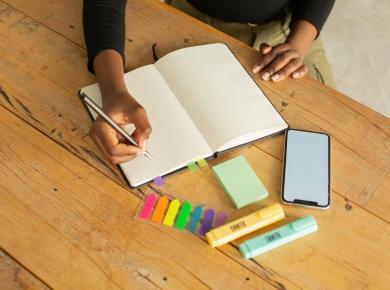Table of Contents
- What Are the Main Four Types of Learning in Education?
- Other Types of Learning Styles
- How Do Students Learn Best?
- Additional Insights into Learning Styles
- Teaching Strategies for Diverse Learning Styles
- Frequently Asked Questions (FAQs)
- What are learning styles, and why are they important?
- How can teachers accommodate diverse learning styles in the classroom?
- Is there a single best learning style for all students?
- How can students identify their preferred learning style?
- Are there other factors besides learning styles that influence how students learn?
Every student has a strategy they use to remember information more efficiently while studying. Some of them take notes; some make diagrams; some prefer to listen to lectures, etc. Since no learning style fits all students, scientists have conducted research in order to understand the way students learn new information best.
Let’s look at the different types of learning they have distinguished.
What Are the Main Four Types of Learning in Education?
We mentioned before that scientists have for years tried to understand the best ways students learn through research. One of the popular theories, to this day, is the VARK model. This model identifies four types of learners: visual, auditory, kinesthetic, and reading/writing.
Most people are a combination of these four styles, but more times than not, they have a predominant style of learning. Each of these styles has a complementary way of teaching. Now, let’s see the characteristics each of these styles entails and how best to make use of them.
Visual learning style

Visual learners are individuals who prefer to take in their information visually—be that with maps, graphs, diagrams, charts, and others. However, they don’t necessarily respond well to photos or videos, rather needing their information using different visual aids such as patterns and shapes.
The best way to present to visual learners is by showing them the relationship between different ideas visually. For instance, when explaining a scientific process, it can be done by using a flow chart.
Auditory learning style

Auditory learners are individuals who learn better when they take in information in auditory form when it is heard or spoken. They are prone to sorting their ideas after speaking rather than thinking ideas through before. Since, to them, saying things out loud helps them understand the concept.
If they are learning a second language or a new theory, auditory learners learn best when information is presented to them via strategies that involve talking, such as lectures and group discussions. They can benefit from repeating the lessons, utilizing technology for recordings of the lectures, doing group activities that require classmates to explain ideas, etc.
Kinesthetic learning style

Kinesthetic learners are individuals who prefer to learn by doing. They enjoy a hands-on experience. They are usually more in touch with reality and more connected to it, which is why they require using tactile experience to understand something better.
The best way to present new information to a kinesthetic learner is through personal experience, practice, examples, or simulations. For instance, they can remember an experiment by recreating it themselves.
Reading/Writing

Reading/writing learners consume information best when it’s in words, whether that’s by writing it down or reading it. To them, text is more powerful than any kind of visual or auditory representation of an idea. These individuals usually perform very well on written assignments.
There are different ways to get a reading/writing learner to engage and understand a certain lesson. For instance, it would be best to have them describe charts and diagrams by written statements, take written quizzes on the topics, or give them written assignments.
Other Types of Learning Styles
Now that we have discussed some learning styles that have been around for a while, it’s time we dug a little deeper and introduced some other lesser-known learning styles. It is important to note that not everyone agrees on the types of learning styles, their names, or even their number. Recent studies and theories from psychologists and experts in the field suggest that there are anywhere between 3 to 170 different types of learning styles. Other types of learning styles, based on one of the senses and a social aspect, include:
Logical/analytical learners
As the name suggests, analytical learners depend on logic and analytical skills to understand a particular subject. These types of learners search for connections, causes, patterns, and results in their learning. A teacher can engage and motivate these students by posing questions that require interpretation, using material that activates problem-solving skills, and stimulating students to reach conclusions based on facts or reasoning.
Social/linguistic learners
These types of learners favor educational lessons that include peer work or participation. Social/ linguistic learners get two things out of this participation: socializing (which they love) and a better understanding of a subject. Teachers can motivate these types of learners by using role-playing and different communication activities, such as encouraging student interaction (asking questions, sharing stories, etc.).
Solitary learners
Otherwise known as solo learners, these students are the opposite of social learners. Solitary learners prefer to study alone without having to interact with other learners. Individual work is a solo student’s forte. Teachers can help these types of learners by using activities that require individual work (including keeping a diary) and problem-solving skills, recognizing a student’s individual accomplishments, etc.
Nature learners
These types of learners excel when in contact with nature. A nature learner’s ideal study environment is a calm and relaxing environment. If we had to compare nature learners with another type, it would be tactile learners. The only difference is the nature part of this deal, as nature learners need to be outside to learn better. While learning in nature may not always be possible, teachers can still nurture this learning style in students by assigning hands-on activities, having classes outdoors when possible, and using nature examples when explaining a new lesson.
How Do Students Learn Best?
Given that everyone has a unique learning method, it would be wrong to say that a specific learning style is the best way to go. However, understanding your or your child’s style of learning is very important.
Since the way someone best consumes information can be a deciding factor in their academic success, understanding what kind of learner they are is vital. You can do this by trying all four methods of learning and then deciding which one helps you remember best. Once you know what kind of style fits you, you can tailor your studies to fit your needs.
✅ Request information on BAU's programs TODAY!
Additional Insights into Learning Styles
Understanding learning styles encompasses a broader spectrum beyond just the VARK model, delving into cognitive, emotional, and environmental factors influencing how individuals prefer to learn.
Cognitive factors influencing learning styles
Cognitive styles, such as sequential versus global processing, contribute significantly to learning preferences. Sequential learners thrive on step-by-step instruction, while global learners prefer grasping the big picture first. Factors like attention span, memory capacity, and processing speed also shape learning preferences.
Emotional factors impacting learning styles
Emotional elements, including motivation and self-esteem, play a crucial role in individuals engaging with different learning styles. Students with high confidence and motivation may readily explore various learning approaches, while those with lower self-esteem might stick to familiar methods.
Moreover, the learning environment, encompassing aspects like noise level, lighting, and physical comfort, can significantly impact receptiveness to different learning styles. Flexibility in the environment, such as offering study location choices or adjusting classroom setups, helps accommodate diverse preferences.
Teaching Strategies for Diverse Learning Styles
Personalized strategies tailored to individual learning styles can enhance engagement and comprehension in teaching. Teachers can provide various learning materials, allow students to choose assignments, or offer alternative assessment methods to cater to varied preferences.
Integrating technology, such as interactive multimedia presentations or online forums, further supports different learning modes. Collaborative learning opportunities, including group activities and peer tutoring, benefit students with social or linguistic learning preferences by fostering interaction and discussion. Conversely, solitary learners may thrive in environments where they can work independently.
Assessment and feedback for learning optimization
Continuous assessment and feedback mechanisms are integral in identifying students’ preferred learning styles and adjusting instructional strategies accordingly. Regular feedback enables students to reflect on their learning processes and refine study habits based on their unique styles.
Moreover, professional development programs for educators can provide training on recognizing and accommodating diverse learning styles in the classroom. Teachers can learn effective instructional strategies tailored to different preferences and gain insights into creating inclusive learning environments.
By embracing the multifaceted nature of learning styles, educators can cultivate environments that cater to the diverse needs of all students.
Frequently Asked Questions (FAQs)
What are learning styles, and why are they important?
Learning styles refer to individual preferences and approaches to acquiring knowledge. Understanding one’s learning style can enhance comprehension and academic success by tailoring study methods to fit individual needs.
How can teachers accommodate diverse learning styles in the classroom?
Teachers can accommodate diverse learning styles by offering a variety of learning materials, allowing for student choice in assignments, integrating technology, fostering collaborative learning opportunities, and providing personalized feedback and support.
Is there a single best learning style for all students?
No, there is no single best learning style for all students. Every individual has a unique learning method that suits them best. It’s essential to explore different learning styles and determine which one works most effectively for each student.
How can students identify their preferred learning style?
Students can identify their preferred learning style by experimenting with different study methods, such as visual, auditory, kinesthetic, and reading/writing techniques. Reflecting on which methods result in better comprehension and retention can help determine their preferred style.
Are there other factors besides learning styles that influence how students learn?
Yes, besides learning styles, other factors such as cognitive abilities, emotional factors like motivation and self-esteem, environmental conditions, and teaching methods also influence how students learn. It’s essential to consider these factors holistically when designing educational strategies.










